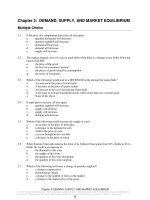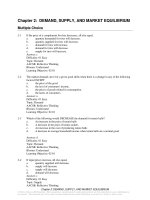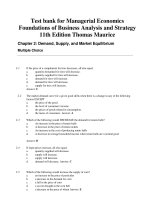Lecture Managerial economics - Chapter 9: Risk analysis and Moral Hazard
Bạn đang xem bản rút gọn của tài liệu. Xem và tải ngay bản đầy đủ của tài liệu tại đây (596.25 KB, 34 trang )
Week 9
Risk Analysis and Moral Hazard
1
Today’s Agenda
1. Risk Analysis
2. Moral Hazard / Principal-Agent Problem
2
Motivation
So far, we assumed there’s no uncertainty in the world.
• In the OPEC game, if Kuwait and Saudi share the market,
they will both earn $180,000.
But, in reality, these payoffs are uncertain.
• In economics, it’s called “risky payoff.”
• In statistics, it’s called “probability distribution”
Most business outcomes are uncertain as well.
• In order to make good business decisions, it’s very
important to understand this uncertainty and to measure the
risk properly.
3
Attitudes toward Risk
Suppose there are two salary options
1. Fixed salary of $100,000
2. Uncertain salary depending on coin toss
outcome
– $0 if Heads and $200K if Tails
The preference between these 2 options will
reveal the attitude toward risk.
4
Attitudes toward Risk (cont)
Risk Averse
• If you prefer options #1, the fixed payoff
Risk Neutral
• If you are indifferent between #1 and #2
Risk Loving
• If you prefer options #2, the uncertain payoff
Almost all people are risk-averse.
• But the degrees of risk-aversion differ among people
• Some people are more risk tolerant than others.
5
Moral Hazard
Let’s consider an auto insurance
• By design, insurance pays for costs if certain events
occur
Insured people may have distorted incentives
• Insurance company wants you to drive safely.
• But the insured may drive less carefully.
Moral hazard
• What the insurance industry calls this distorted
incentive
6
The Principal-Agent Model
Moral hazard
• Economists use “principal-agent models” to
analyze moral hazard
The Principal-Agent Model
• agents work on behalf of the principals
• the problem of different incentives between agent
and principal
• occurs because of asymmetric information
7
Principal-Agent Problem (cont)
Asymmetric Information
• One party has more private information than the other
• The party with private information is called “Agent”
• The other party without private information is called
“Principal”
There are many applications of principal-agent problem
• Shareholders vs. Managers (in corporate finance)
• Employer vs. Employee (managerial accounting)
• Politicians vs. Public (in political science)
• unemployment, life, & auto insurance (in economics)
8
Solving principal-agent model
Several methods depending on the case
1. Monitor agents more carefully
• have health insurance customers come in for regular exams
• monitor employees at work
– Monitoring can be too costly
2. Use appropriate incentives
• co-payments in insurance
• performance based salary pay
3. New idea: give ownership to the agent
• independent contracting instead of employment
• outsourcing
• franchising
9
Adverse Selection
Suppose you purchase a new car for $20,000
• drive it for 1 day & then sell it the next day
–what would a buyer think about your car?
–what price will you get for your car? Why?
Asymmetric information:
• sellers know the true quality, but buyers do not
• this leads to adverse selection, often known as the
“lemons problem”
–George Akerlof (2001 Nobel prize)
10
Lemons Problem in Used Car Market
Adverse selection problem
• Suppose there’s an average fair price for used cars
• If the seller has good quality car with higher value than this
price, he will not sell it
• Only the “lemons” (cars with defects) will remain in the
market.
–Adverse selection arises.
→ Bad cars drive out the good cars from the used car market
• This will further drive down the used car price.
Q: If you are a good car seller, what can you do?
11
How to Fix Adverse Selection?
Create a market for information
• Reveal information
– Carfax
– Better Business Bureau (BBB)
– quality data, product analysis, product
inspection, credit ratings, etc.
• hire a mechanic to check the used car
• build seller reputation: brand names
Signaling
• Warranties & other guarantees
Self-Selection
12
Signaling
high quality types to signal their quality
• Usually, signaling occurs when the seller has private
information
– Seller with high quality product wants to convey the
private information to the buyers
– Low quality product can’t match it
• Examples
–a high quality used car comes with an extended
warranty
–a high quality house comes with disclosed home
inspection records
13
Conditions for Credible Signaling
1. Signaling should reveal true quality
• Low quality types will have less incentive to
follow the high quality types.
2. Low signaling cost
• should be low enough for the high quality type to
invest
14
Implications for Used Cars
If you are a potential buyer,
• Check whether the seller offers extended warranty
–if he doesn’t, the car is likely to be a lemon.
• Ask for all the previous repair/maintenance works.
• Anything strategy to avoid the lemons?
If you are a seller with a good quality car,
• disclose all the information such as maintenance
services.
–By signaling, buyers will find it’s a good quality car
–You will have a better chance to charge more
» Sometimes, it pays to disclose private information
15
Auto Insurance
• Insurance company knows that there are high risk
drivers and low risk drivers. But it can’t tell one
from the other.
• Drivers themselves know whether they are good
or bad drivers.
– Buyers have private information
→ Contrary to the used car case
If the insurance company offers just one type of
auto insurance policy, what will happen?
16
Adverse Selection in Auto Insurance
Adverse Selection in Auto Insurance
• Only the bad drivers will get the insurance
• Insurance companies will lose money.
How to solve this adverse selection?
• Self-Selection
–Rothschild and Stiglitz’s idea
–Stiglitz won the 2001 Nobel prize
Idea: Design multiple policies such that
• One for the good drivers
• Another for the bad drivers
17
A Possible Self-Selection Solution
18
Moral Hazard vs. Adverse Selection
These two are both caused by asymmetric information.
• But they are not identical problems.
What is the difference between these two problems?
19
Summary
Adverse Selection:
• If there’s private information to one party, bad guys
will drive out the good guys from the market.
– which leads to inefficiency or worst outcome
• Used car market
– Seller has private information
• Insurance market
– Buyers have private information
How to solve the adverse selection problem?
• Signaling
• Self-selection
20
Auction
1. Auction Types
2. Class experiment
• dollar auction
3. Keys to eBay’s success
4. Types of Bidding strategies in eBay
5. Winner’s Curse
21
Online Auction
Revenues from online auctions
• $6.5 billion in 2000
• $30 billion in 2003
• Expected growth rate of 68% through 2006
Up to the third-quarter of 2012, Net revenue of
$10.079 billion, up to 21.8% from $8.272
billion in the same period of 2011.
22
Normal Auction vs. Reverse Auction
Normal Auction
• A service or product is made available by the seller
• Buyers bid for the ownership rights
Reverse Auction
• Buyer announces the need for a product or service
• Sellers bid for the right to sell the buyer.
23
Types of Auction Mechanisms
English Auction
• Ascending-bid
• Most common, Standard form for eBay
Dutch Auction
• Descending-bid
– The price decreases until a buyer bids
• In eBay, used for large quantity auctions
– All winners pay the lowest winning bid
Sealed-Bid Auction
• Mainly used for reverse auctions
Second-Price, Sealed-Bid Auction
• Vickrey, 1996 Nobel Price
24
Keys to Ebay’s Success?
Network Externality
• eBay: customer to customer (C2C) internet business
• Needs to get critical mass
–First movers advantage
–Many other auction sites failed
» Onsale.com, ubid.com (?)
Customer Service
• Feedback Ratings
–biggest fear among online customers = Fraud, Scam
–Ratings provide a safety check to the customers
• Easing the transaction between buyer and seller
–purchasing paypal
25









